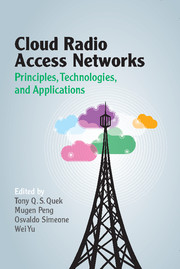Book contents
- Frontmatter
- Contents
- Acknowledgments
- Foreword
- Preface
- List of Contributors
- Part I Architecture of C-RANs
- Part II Physical-Layer Design in C-RANs
- Part III Resource Allocation and Networking in C-RANs
- 10 Resource Management of Heterogeneous C-RANs
- 11 Coordinated Scheduling in C-RANs
- 12 Delay-Aware Radio Resource Allocation Optimization in Heterogeneous C-RANs
- 13 C-RAN Using Wireless Fronthaul: Fast Admission Control and Large System Analysis
- 14 Toward Green Deployment and Operation for C-RANs
- 15 Optimal Repeated Spectrum Sharing by Delay-Sensitive Users
- Part IV Networking in C-RANs
- Index
- References
11 - Coordinated Scheduling in C-RANs
from Part III - Resource Allocation and Networking in C-RANs
Published online by Cambridge University Press: 23 February 2017
- Frontmatter
- Contents
- Acknowledgments
- Foreword
- Preface
- List of Contributors
- Part I Architecture of C-RANs
- Part II Physical-Layer Design in C-RANs
- Part III Resource Allocation and Networking in C-RANs
- 10 Resource Management of Heterogeneous C-RANs
- 11 Coordinated Scheduling in C-RANs
- 12 Delay-Aware Radio Resource Allocation Optimization in Heterogeneous C-RANs
- 13 C-RAN Using Wireless Fronthaul: Fast Admission Control and Large System Analysis
- 14 Toward Green Deployment and Operation for C-RANs
- 15 Optimal Repeated Spectrum Sharing by Delay-Sensitive Users
- Part IV Networking in C-RANs
- Index
- References
Summary
Introduction
In the wireless network literature, scheduling denotes the strategy according to which users are active at each time-frequency resource block. In this classical literature, scheduling is done per base station (BS), i.e., without coordination between the BSs. With the large demand for mobile data services that is straining wireless networks nowadays, coordination among transmitters becomes a real necessity to better manage the high levels of interference.
The C-RAN architecture is a practical platform for the implementation of coordinated multi-point (COMP) systems. By connecting all BSs to a central computing center (i.e., a cloud) via wire or wireless backhaul links, C-RAN allows joint signal processing and coordinated resource allocation at the cloud. Depending on the capacity of the connecting backhaul, the level of coordination among the BSs may vary from a high coordination level (e.g., signal-level coordination as in fiber optic high-capacity backhaul links) to a low coordination level (e.g., resource allocation coordination as in wireless backhaul links). In situations where optical fiber backhaul links are unavailable at the exact location of a BS, or when the extension of optical fiber cables to the base station location is prohibitively expensive, wireless backhauls become a cheaper and easier-to-deploy solution. Intelligently devising schemes for the coordination of resource allocation in a C-RAN setup is, therefore, a real necessity for providing a practical, reliable, and scalable solution to the impending capacity crunch.
From the recent literature, coordinated resource allocation can be classified into three categories:
• coordinated beamforming;
• coordinated power control;
• coordinated scheduling.
While adjustment of the continuous variables (i.e., the beamforming vectors and the power) typically requires high-resolution algorithms and sensitive hardware physical platforms, discrete allocation (i.e., scheduling) is considered a more practical resource-allocation solution. Scheduling problems are, nevertheless, discrete optimization problems which may be often NP-hard problems. This chapter provides a framework for solving coordinated scheduling problems in C-RANs, using graph theory practical techniques that perform close-to-optimal solutions.
In conventional cellular network architecture, scheduling policies are often performed per base station given a pre-known association of users and base stations, e.g., the classical proportionally fair scheduling [1, 2]. One point illustrated in this chapter is that coordinated scheduling not only allows assigning users to resource blocks across the network but also jointly solves for the user-to-BS association problem.
Information
- Type
- Chapter
- Information
- Cloud Radio Access NetworksPrinciples, Technologies, and Applications, pp. 255 - 281Publisher: Cambridge University PressPrint publication year: 2017
